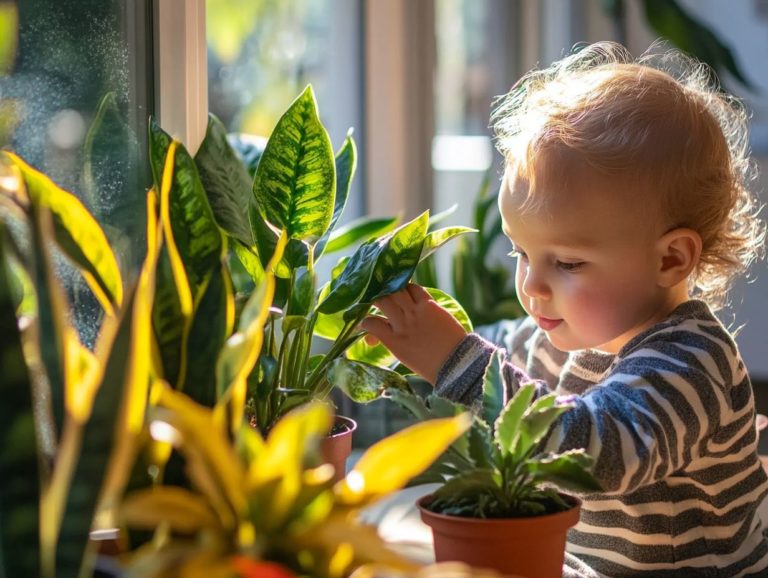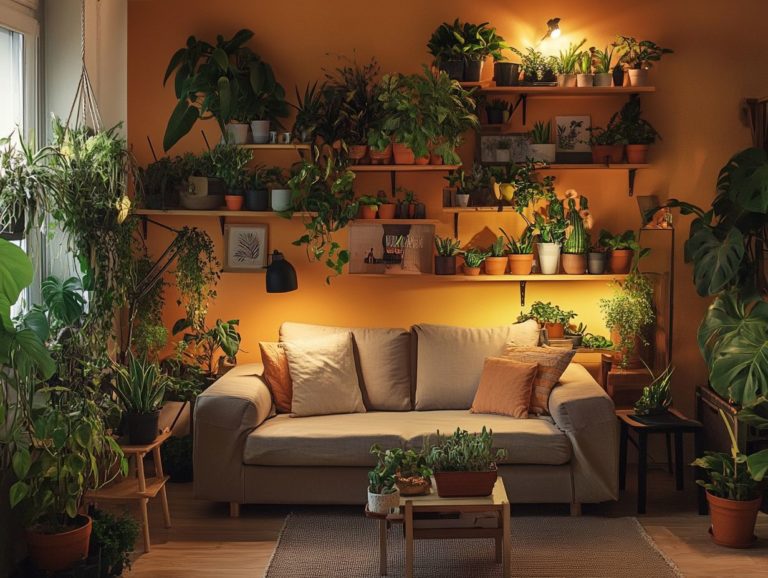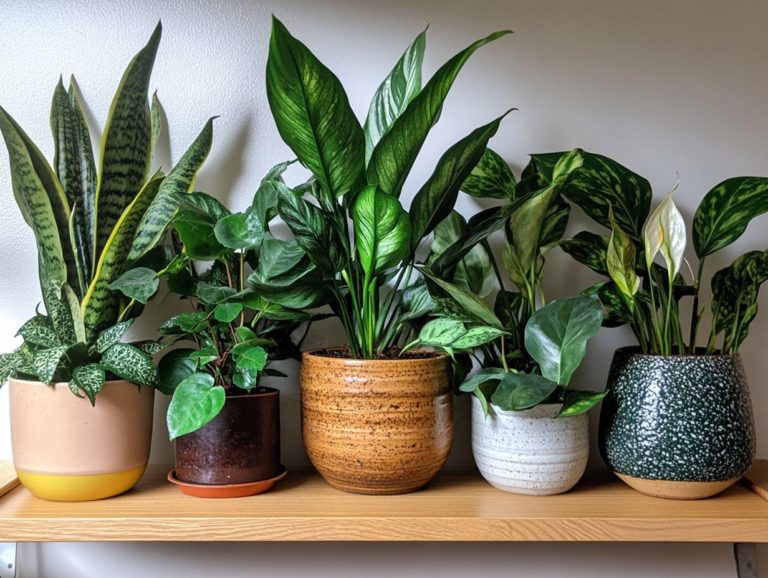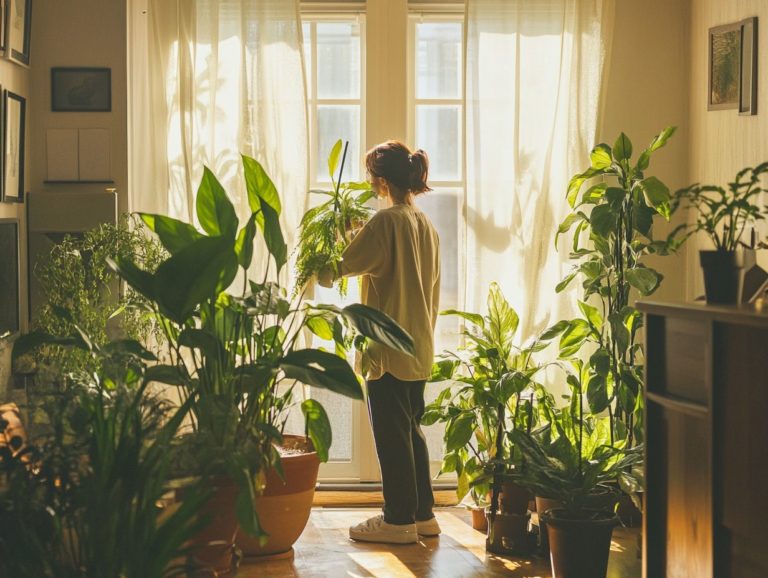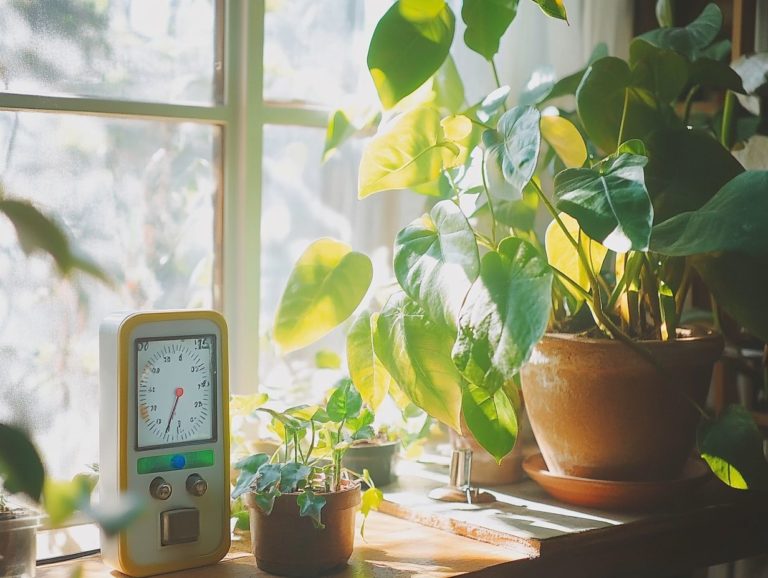What is the Life Cycle of Indoor Plants?
Indoor plants and house plants infuse your home with beauty and vitality. Understanding their life cycle can elevate your gardening experience to new heights.
This guide will take you on a journey through the various stages of indoor plants, from germination to growth, reproduction, and beyond. You ll uncover the best conditions needed to nurture these green companions, effective maintenance practices, and common challenges that may arise along the way.
Whether you re a seasoned plant parent or just beginning your journey, you ll discover valuable insights that will empower your indoor garden to flourish and enhance the lifespan of your houseplants.
Contents
- Key Takeaways:
- The Life Cycle of Indoor Plants
- Germination
- Growth and Development
- Reproduction
- Maintenance and Care
- Common Issues and Solutions
- End of Life
- Frequently Asked Questions
- What is the Life Cycle of Indoor Plants?
- What are the different stages in the life cycle of indoor plants?
- How long does it take for an indoor plant to go through its life cycle?
- What factors can affect the life cycle of indoor plants?
- How can I promote a healthy life cycle for my indoor plants?
- What happens during the old age stage of an indoor plant’s life cycle?
Key Takeaways:
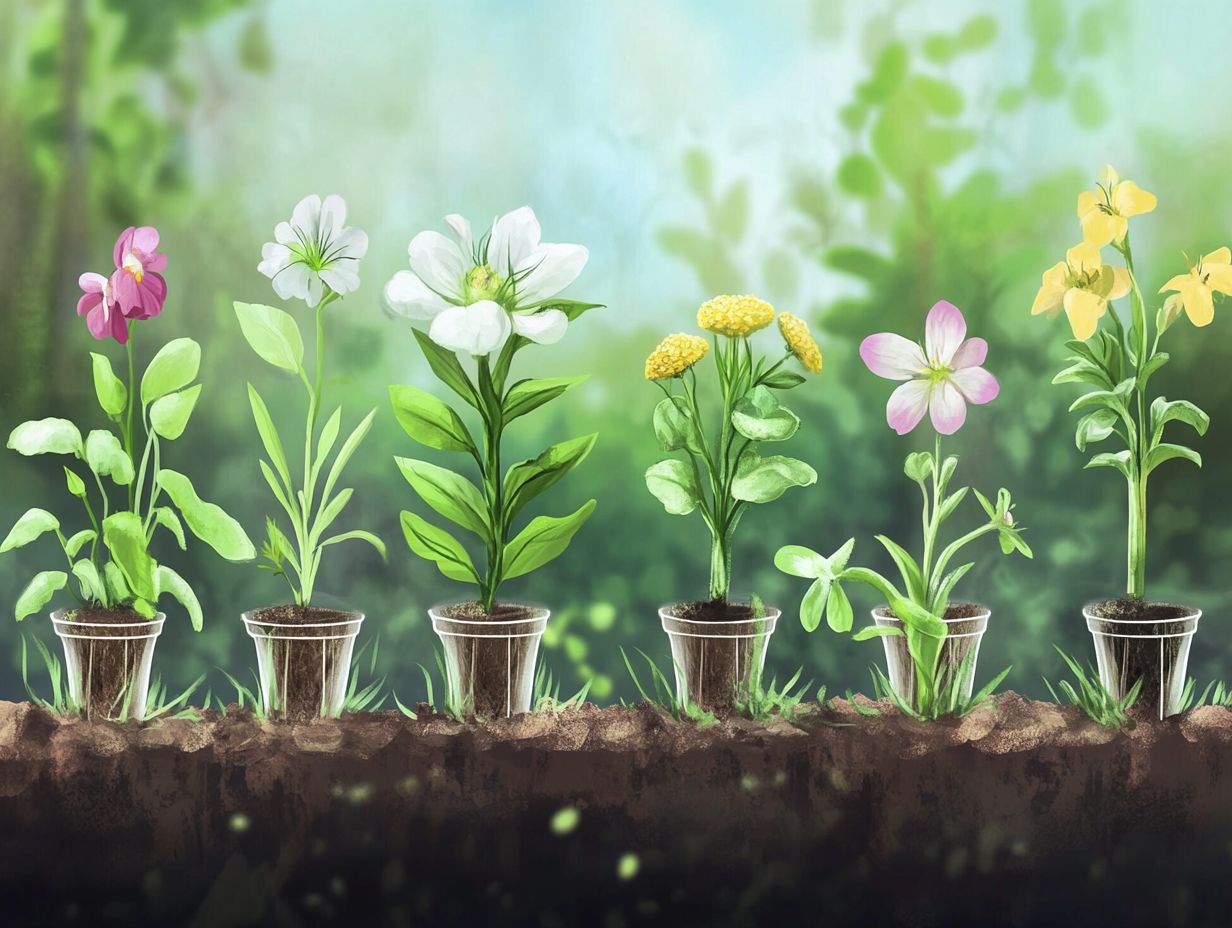
- Indoor plants go through various stages in their life cycle, including germination, growth, reproduction, and aging.
- Factors like temperature, light, and soil quality can affect the germination process of indoor plants.
- Providing the best conditions, such as the right amount of sunlight, water, and fertilization, is crucial for the growth and development of indoor plants.
The Life Cycle of Indoor Plants
The life cycle of indoor plants unfolds through a series of stages: germination, growth, reproduction, and aging. Grasping these stages not only enhances your indoor gardening experience but also gives you the power to nurture your plants effectively, ensuring their longevity and prosperity.
As you embark on this journey, remember that elements like optimal lighting are essential for extending the life of your houseplants. Proper watering and suitable soil conditions also encourage fresh growth and preserve vibrant foliage.
Overview of the Stages
The life cycle of indoor plants unfolds in distinct stages: germination, growth, reproduction, and aging. Each stage is important for understanding plant health and maintenance.
Germination is where it all begins, as seeds awaken and sprout, relying on the right blend of moisture and warmth. Next, the growth phase becomes crucial. To thrive, your plants need the right amount of water and plenty of light. For example, Spider Plants thrive and display rapid leaf development under the right conditions, similar to Pothos and Snake Plants.
Reproduction follows, where fertilizing your plants takes center stage. Many houseplants, including Orchids, depend on specific nutrients to produce those stunning blooms you admire. Finally, we encounter aging, a natural decline that requires your attention. Pruning and care during this phase can help prolong your plants’ life.
By understanding these stages, you can cultivate a thriving indoor garden that delights the senses and enriches your living space.
Germination
Germination marks the initial stage of the plant life cycle. Seeds burst forth and begin their growth journey. To thrive, they require the perfect blend of potting soil, moisture, and optimal light conditions.
This stage is important for indoor plants as it lays the foundation for their future growth and development.
Factors Affecting Germination
Several factors influence germination, including temperature, moisture levels, and light exposure. These are crucial for the successful sprouting of seeds in your indoor garden. By understanding these elements, you can extend the lifespan of your houseplants and create the best conditions for their growth.
These factors work together to cultivate a nurturing environment that promotes robust development and improves air quality. For example, the ideal temperature range varies by plant type. While the Boston Fern thrives in cool, humid settings, other plants, like Rubber Plants, prefer warmer temperatures.
Insufficient moisture can lead to seed dormancy (which means seeds are inactive until growth conditions are right) or cause seedlings to wilt, highlighting the delicate balance required for successful germination. Improper light conditions can lead to leggy plants (tall and weak plants due to insufficient light) or stunt growth entirely.
To tackle these challenges, stay vigilant in monitoring moisture levels, use grow lights when natural sunlight is scarce, and adjust temperatures to suit the specific needs of your plants.
Growth and Development

Growth and development represent a stage where your indoor plants truly thrive, showing off fresh leaves and vibrant colors, indicating a healthy home.
This phase demands your attentive care. Meeting each plant’s unique needs is essential for their well-being and vitality.
Optimal Conditions for Growth
Creating optimal conditions for growth is key to nurturing healthy indoor plants. You ll find that the right balance of watering, fertilizing, and light exposure enhances their well-being and encourages vibrant new growth.
Humidity and temperature are key for thriving plants. For example, air plants love humidity; they thrive best around 60% to 70% humidity.
They also enjoy temperatures ranging from 70 to 90 degrees Fahrenheit. The Christmas cactus thrives in cooler temperatures, preferring conditions between 60 and 70 degrees Fahrenheit an ideal fit for indoor settings.
Incorporating these plants into your space does more than just beautify; it significantly improves air quality, contributing to a healthier living environment. By paying attention to proper air circulation and light requirements and providing routine care, you can avoid common pitfalls. This ensures your indoor companions remain lush and vibrant.
Reproduction
Reproduction in house plants unfolds through various methods, including sexual reproduction via seeds and asexual techniques like cuttings or division.
Mastering these techniques is essential for anyone serious about indoor gardening. By grasping the nuances of these propagation methods, you empower yourself to expand your plant collection with finesse and confidence.
Methods of Reproduction
Methods of reproduction in indoor plants include propagation by cuttings, division, and layering. Each offers distinct advantages as you seek to grow your indoor gardening collection.
Understanding how to use these methods effectively can greatly enhance the growth and vitality of your plants. For instance, when you propagate by cuttings, you take a healthy segment of a plant that has several leaves and place it in suitable growth medium. Division involves carefully separating root balls, allowing each section to develop its own root system. Layering means bending a stem into the soil to encourage root formation before you detach it.
Be mindful of potential challenges like root rot, insufficient light, or pests that could hinder your success. Take action to avoid these issues by regularly monitoring your plants, maintaining optimal moisture levels, and ensuring they receive adequate light exposure. This will promote lush, healthy foliage and elevate your indoor gardening experience.
Maintenance and Care
Caring for your plants is essential for success, allowing them to thrive and maintain their vibrant allure.
Engaging in regular practices like pruning, watering, and fertilizing enhances their visual appeal and contributes to their longevity.
Your attentive care transforms your indoor space into a lush sanctuary, ensuring that each plant flourishes beautifully over time.
Pruning, Watering, and Fertilizing

Pruning, watering, and fertilizing are essential practices for maintaining your indoor plants. Each practice plays a distinct role in fostering healthy growth and preventing common issues.
By understanding the specific needs of each plant type, including the Boston Fern, Christmas Cactus, and Weeping Fig, you can significantly enhance their vitality.
For optimal watering, it’s wise to establish a schedule that adapts to the seasons. Water more frequently during the warm months and less so in winter to ensure the roots receive the right amount of moisture.
Incorporating a balanced, slow-release fertilizer a type of fertilizer that gradually provides nutrients over time every six to eight weeks during the growing season provides your plants with the essential nutrients they need for robust development.
Regularly inspecting your plants for yellowing leaves or unusual spots is crucial. These can signal underlying problems such as pests or diseases.
When you notice any symptoms, act quickly to isolate affected plants and apply the appropriate treatments for common plant problems. This can help mitigate further damage and keep your indoor garden thriving.
Common Issues and Solutions
Common challenges in indoor gardening, such as pests and diseases, can pose a significant threat to the well-being of your houseplants. However, with timely intervention and the right solutions, you can effectively manage these issues and foster a thriving environment for your plants.
Dealing with Pests and Diseases
Dealing with pests and diseases is a crucial part of caring for your plants. It s essential to be aware of common threats and effective solutions to protect the health of your indoor greenery.
Keep an eye out for potential invaders like aphids, spider mites, and whiteflies. They often make their presence known through sticky residue or discolored leaves.
Fungi such as powdery mildew can appear as a dusty coating, signaling that immediate attention is required. Preventive measures are key.
Maintaining adequate humidity levels and ensuring good air circulation can go a long way. Regularly inspect your plants for early signs of trouble.
When outbreaks occur, organic treatments like neem oil a natural pesticide derived from the seeds of the neem tree and insecticidal soap can be your best allies. Consistent sanitation practices, like cleaning pots and tools, will help minimize the risk of infestation.
Embrace these strategies to nurture your green companions and watch them thrive!
End of Life
The conclusion of an indoor plant’s life often reveals several signs of aging that deserve your attention. Recognizing these indicators is essential, as it enables you to prepare effectively for the next cycle of growth or consider a thoughtful replacement.
Signs of Aging and Preparing for the Next Cycle
Signs of aging in your indoor plants can manifest as yellowing leaves, stunted growth, and the presence of pests. These all signal the need for intervention to prepare for their next growth cycle.
By keenly observing these indicators, you can implement strategic care measures to rejuvenate your plants effectively. Providing adequate sunlight is essential; many houseplants, such as pothos and spider plants, thrive best under bright, indirect light.
Another effective strategy is to refresh the soil. Nutrient depletion can significantly hinder growth, and incorporating organic compost can work wonders in revitalizing your plants.
Regularly checking for pests and applying natural treatments is also a key element in maintaining plant health. Embrace the idea that transitioning to new plants can be a rewarding experience.
Selecting resilient varieties can enhance the vitality of your indoor garden, making it a lush and vibrant retreat.
Frequently Asked Questions

What is the Life Cycle of Indoor Plants?
The life cycle of indoor plants refers to the stages of growth and development that a plant goes through from its seedling stage to maturity and eventually death.
What are the different stages in the life cycle of indoor plants?
Indoor plants undergo four main stages: germination, vegetative growth, reproductive growth, and old age.
How long does it take for an indoor plant to go through its life cycle?
The duration of an indoor plant’s life cycle varies by type. On average, it can take several months to several years.
What factors can affect the life cycle of indoor plants?
Several factors influence the life cycle of indoor plants. These include light, water, temperature, humidity, nutrients, and pests.
How can I promote a healthy life cycle for my indoor plants?
To keep your indoor plants thriving, provide them with enough light, water, and nutrients. Protect them from pests and diseases, and consider regular pruning and repotting to encourage growth.
What happens during the old age stage of an indoor plant’s life cycle?
Old age marks the aging process of indoor plants. Signs include yellowing leaves and reduced growth, leading to wilting and death. While this is natural, proper care can delay it.


